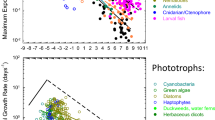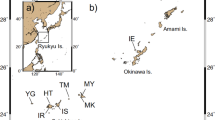Abstract
Is protein polymorphism adaptive or neutral1? Attempts to assess the neutrality theory on the basis of gene frequencies and theoretical population genetics models seem, at least to some authors, to be unsuccessful2. Possible promising approaches involve the search for direct correlation of isozymes with the environment1 and with physiological function3. We have tested the effects of temperature on barnacles, because temperature affects protein structure and function4,5,6, as well as size7, and because adult barnacles, following larval settlement, are stationary and directly exposed to local temperature variation. Our results suggest strong temperature selection on allozymic and size variations in the acorn barnacle, Balanus amphitrite.
This is a preview of subscription content, access via your institution
Access options
Subscribe to this journal
Receive 51 print issues and online access
$199.00 per year
only $3.90 per issue
Buy this article
- Purchase on Springer Link
- Instant access to full article PDF
Prices may be subject to local taxes which are calculated during checkout
Similar content being viewed by others
References
Lewontin, R. C. The Genetic Basis of Evolutionary Change (Columbia University Press, New York, 1974).
Ewens, W. J. & Feldman, M. W., In Population Genetics and Ecology (eds S. Karlin & E. Nevo) (Academic, New York, 1976).
Johnson, G. B. Science 184, 28–37 (1974).
Hochachka, P. W. & Somero, G. N. Strategies of Biochemical Adaptation (Saunders, Philadelphia, 1974).
Somero, G. N., In Isozymes II (ed. C. L. Markert) 221–234 (Academic, New York, 1975).
Moon, T. W., In Isozymes II (ed. C. L. Markert) 207–220 (Academic, New York, 1975).
Ray, C. J. Morphol. 106, 85–108 (1960).
Selander, R. K., Smith, M. H., Yang, S. Y., Johnson, W. E. & Gentry, G. B. Univ. Texas Publication 7103, 49–90 (1971).
Nei, M. Am. Nat. 106, 283–292 (1972).
Thorhaug, A., Segar, D. and Roessler, M. A. Mar. Pollut. Bull. 7, 165–169 (1976).
Thorhaug, A. In Thermal Ecology (eds J. W. Gibbous & Saritz, R. R.) (AEC Symp. series, in the press).
Somero, G. N. Am. Nat. 103, 517–530 (1969).
Dobzhansky, Th. Genetics and the Origin of Species (Columbia University Press, New York, 1951).
Levins, R. Evolution in changing environments (Princeton University Press, Princeton, New York, 1968).
Powell, J. R. Science 174, 1035–1036 (1971).
McDonald, J. F. & Ayala, F. J. Nature 250, 572–574 (1974).
Koehn, R. K. Science 163, 943–944 (1969).
Koehn, R. K., Perez, J. E., Merritt, R. B. Am. Nat. 105, 51–69 (1971).
Mitton, J. B. & Koehn, R. K. Genetics 79, 97–111 (1975).
Johnson, G. B. Biochem. Genet. 14, 403–426 (1976).
Fleiss, J. L. Statistical Methods for Rates and Proportions (Wiley, New York, 1973).
Author information
Authors and Affiliations
Rights and permissions
About this article
Cite this article
NEVO, E., SHIMONY, T. & LIBNI, M. Thermal selection of allozyme polymorphisms in barnacles. Nature 267, 699–701 (1977). https://doi.org/10.1038/267699a0
Received:
Accepted:
Published:
Issue Date:
DOI: https://doi.org/10.1038/267699a0
This article is cited by
-
Population genomics of rapid evolution in natural populations: polygenic selection in response to power station thermal effluents
BMC Evolutionary Biology (2019)
-
Natural selection causes microscale allozyme diversity in wild barley and a lichen at ‘Evolution Canyon’, Mt. Carmel, Israel
Heredity (1997)
-
Seasonal variation at four loci in a continuously breeding population of Danaus plexippus L.
Heredity (1993)
-
Effetti gemetici delľinquinamento in popolazioni lagunari di Balanus amphitrite Darwin (Cirripedia: Thoracica)
Rendiconti Lincei (1990)
-
Studies on differential fitness of PGI genotypes with regard to temperature in Gammarus insensibilis (Crustacea: Amphipoda)
Marine Biology (1989)
Comments
By submitting a comment you agree to abide by our Terms and Community Guidelines. If you find something abusive or that does not comply with our terms or guidelines please flag it as inappropriate.



